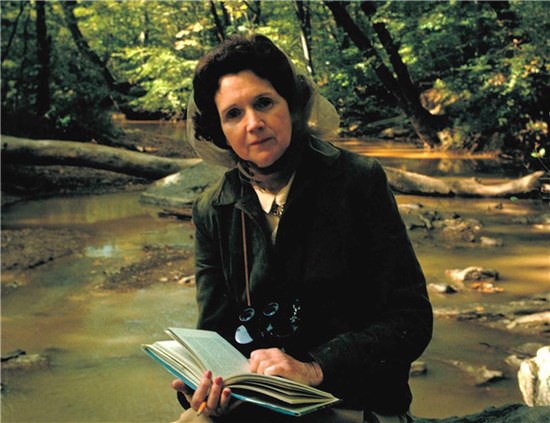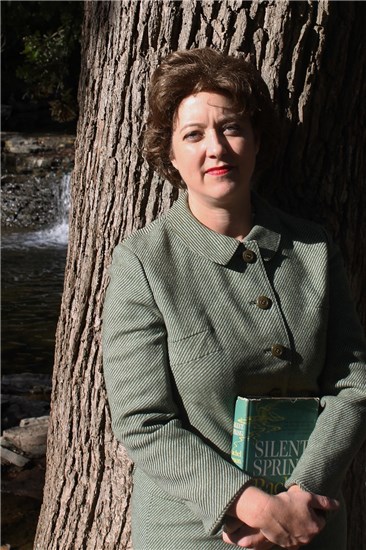

Rachel Carson (1907-1964)
by Leslie Goddard
Sponsored by the Richard and Mary Kemme Family Foundation
In April 1963, Rachel Carson appeared on the television show CBS Reports to discuss her new book, Silent Spring. The book, a denunciation of the indiscriminate use of chemical pesticides, had already sold more than 100,000 copies. Weakened by cancer and wearing a dark wig, Carson responded to chemical industry spokesmen who called her book exaggerated and hysterical.
Leaning heavily in her chair, she spoke calmly and confidently, saying “Unless we do bring these chemicals under better control, we are certainly headed for disaster. …You can’t just step in with some brute force and change one thing without changing many others.”
These were revolutionary claims for Americans, who had long believed science was making the world ever more perfect. And no one looked less likely lead this revolution than this mild-mannered woman.
But Carson’s success was no fluke. She was America’s pre-eminent naturalist, with three bestselling books to her name, including the 1951 blockbuster The Sea Around Us. She had worked nearly twenty years as a writer and editor with the U.S. Fisheries Bureau, where she honed her skill at synthesizing complex information and crafting engaging narratives.
Yet even as she was writing about marine life and the sea, Carson was collecting information about the dangers of new chemical pesticides emerging after World War II. And by the early 1960s, her audience was primed for this message, having seen scares over poisoned cranberries and drugs that caused birth defects, not to mention the threat of nuclear war.
Carson’s writing in Silent Spring was masterful. She skillfully drew parallels between pesticide contamination and nuclear fallout, both invisible threats that kill indiscriminately. She showed a knack for hitting the right note, sometimes using clear, authoritative language and sometimes tugging the heartstrings with lyricism. Even before the book hit shelves, the chemical industry was flooding newspapers, universities, librarians, and public officials with reviews denouncing the book as “biased” and “alarmist.” Carson was labelled a hysteric, a nature nut, and a Communist.
Carson was experienced at handling challenges. She had endured a hardscrabble childhood, growing up in poverty with a father who was never a dependable breadwinner. He died in 1935, leaving her the family’s sole income producer at age 28. She adopted her great-nephew after her niece died in 1957. In the four years she spent writing Silent Spring, she struggled through her mother’s death, crippling health problems, and a double mastectomy.
Carson succumbed to breast cancer 18 months after Silent Spring debuted. She did not live to see the flourishing of the environmental movement of the late 1960s. She never knew about the creation of the U.S. Environmental Protection Agency in 1970, the banning of DDT in 1972, and the many conservation areas, trails, schools and landmarks named for her.
She never learned that Silent Spring would appear on lists of the “100 most influential books of the 20th century.” And that she herself would be named one of the “100 most influential people of the 20th century.”
Recommended Reading
Carson, Rachel. Silent Spring. 1962. 40th anniversary ed., Houghton Mifflin, 2002.
Lear, Linda, Rachel Carson: Witness for Nature. Mariner, 2009. Extensively researched and detailed biography of Carson; written by an environmental historian.
Lytle, Mark. The Gentle Subversive: Rachel Carson, Silent Spring, and the Rise of the Environmental Movement. Oxford University Press, 2007.
Matthiessen, Peter, ed. Courage for the Earth: Writers, Scientists, and Activists Celebrate the Life and Writing of Rachel Carson. Mariner, 2007.
Musil, Robert K. Rachel Carson and her Sisters: Extraordinary Women Who Have Shaped America’s Environment. Rutgers University Press, 2015.
Children’s Book: Lawlor, Laurie and Laura Beingessner. Rachel Carson and Her Book that Changed the World. Holiday House, 2014.
Leslie Goddard
Leslie Goddard, Ph.D., is an award-winning actress and scholar who has been portraying famous women in history for more than a dozen years. She presents more than 350 performances, lectures, and workshops annually, and her programs have been seen by audiences in more than 15 states. A lifelong resident of Illinois, she is the author of two books on Chicago history and currently works full-time as a living-history interpreter and public speaker. She holds a master’s degree in theater from the University of Illinois and an interdisciplinary Ph.D. in theater and U.S. history from Northwestern University.
Bullet Points
-
Rachel Carson wrote the blockbuster best-seller Silent Spring, which is widely considered one of the best and most influential books of the 1960s, if not the entire 20th century. Silent Spring detailed the dangers to all natural systems from the indiscriminate use of chemical pesticides such as DDT. In a broader sense, it questioned the scale and focus of modern science and launched the modern environmental movement. The book, published on Sept. 27, 1962, flew off the shelves, aided by its three-part serialization in The New Yorker that summer and its selection for the Book-of-the-Month Club. Nearly half a million copies of Silent Spring were sold in its first six months alone. It has never been out of print and is regularly included on lists of the most influential books in American history.
-
Silent Spring ignited the modern environmental movement in the 1960s. In the decade after Silent Spring’s publication, environmentalism grew into a mass social movement, as the older conservation movement transformed into the broader, more comprehensive environmental movement. Activists saw numerous successes in the late 1960s and early 1970s, including the Clean Air and Water Acts, the establishment of Earth Day, the founding of the Environmental Protection Agency, and the ban on DDT. More broadly, Carson's contention that humans are not above the natural world but rather a part of it, and that the balance of nature is critical to the survival of humanity, came into popular acceptance.
-
Silent Spring inspired a paradigm shift in Americans’ thinking about the existing world. Silent Spring was more than a study of the effects of synthetic pesticides; it was an indictment of prevailing attitudes of the 1950s. Humans, Carson argued, are part of nature and it is arrogant to think we can dominate nature through chemistry in the name of progress. Silent Spring was among a group of significant books that set the tone for the 1960s, expressing a growing skepticism about the status quo. Silent Spring, along with other books such as Ralph Nader’s Unsafe at Any Speed, Jane Jacobs’s Death and Life of American Cities, and Betty Friedan’s Feminine Mystique, argued that existing social, economic and cultural systems needed radical rethinking.
Quotes
“The more clearly we can focus our attention on the wonders and realities of the universe about us, the less taste we shall have for its destruction.”
“Those who contemplate the beauty of the earth find reserves of strength that will endure as long as life lasts.”
“In nature, nothing exists alone.”
“But man is a part of nature, and his war against nature is inevitably a war against himself.”
“The human race is challenged more than ever before to demonstrate our mastery – not over nature but of ourselves.”
“The ‘control of nature’ is a phrase conceived in arrogance, born of the Neanderthal age of biology and ... the convenience of man.”
“If there is poetry in my book about the seas, it is not because I deliberately put it there but because no one could write truthfully about the sea and leave out the poetry.”
“One way to open your eyes is to ask yourself, ‘What if I had never seen this before? What if I knew I would never see it again?’”
“We stand now where two roads diverge. But unlike the roads in Robert Frost's familiar poem, they are not equally fair. The road we have long been traveling is deceptively easy, a smooth superhighway on which we progress with great speed, but at its end lies disaster. The other fork of the road – the one less traveled by – offers our last, our only chance to reach a destination that assures the preservation of the earth.”
"To stand at the edge of the sea, to sense the ebb and flow of the tides, to feel the breath of a mist moving over a great salt marsh, to watch the flight of shore birds that have swept up and down the surf lines of the continents for untold thousands of years, to see the running of the old eels and the young shad to the sea, is to have knowledge of things that are as nearly eternal as any earthly life can be."
“If I had influence with the good fairy who is supposed to preside over the christening of all children, I should ask that her gift to each child in the world be a sense of wonder so indestructible that it would last throughout life, as an unfailing antidote against the boredom and disenchantment of later year…the alienation from the sources of our strength.”
Timeline
1907 - Rachel Carson born in Springdale, PA on May 27
1932 - Graduates from the Johns Hopkins University with a master’s degree in zoology
1935 - Begins work with the U.S. Bureau of Fisheries, eventually promoted to Editor-in-Chief of all publications for the U.S. Fish and Wildlife Service
1941 - Publishes Under the Sea Wind, the first of her three books about the ocean
1951 - Publishes The Sea Around Us, which spends 86 weeks on the New York Times’ bestseller list, 39 of them in first place. Excerpted in New Yorker. Translated into 30 languages. Wins National Book Award. Made into an RKO film that wins the Oscar for best documentary. Resigns from government service to write full-time.
1955 - Publishes The Edge of the Sea. Also on bestseller list and excerpted in New Yorker
1957 - Adopts her niece’s five-year-old son, Roger Christie, after the death of his mother
1960 - Undergoes radical mastectomy for breast cancer
1962 - Publishes Silent Spring. Excerpted in New Yorker. Receives Albert Schweitzer Medal of Animal Welfare Institute. Audubon Medal of National Audubon Society. Cullum Medal of American Geographic Society. National Wildlife Federation “Conservationist of the Year” award.
1963 - CBS Reports TV special “The Silent Spring of Rachel Carson” airs in April. Testifies before two U.S. Senate subcommittees on misuse of pesticides. President’s Science Advisory Committee issues report endorsing Carson’s findings.
1964 - Dies of breast cancer in Silver Spring, MD, on April 14 at age 56
1965 - The Sense of Wonder published (posthumously)
1980 - Awarded Presidential Medal of Freedom, the highest civilian award of the United States